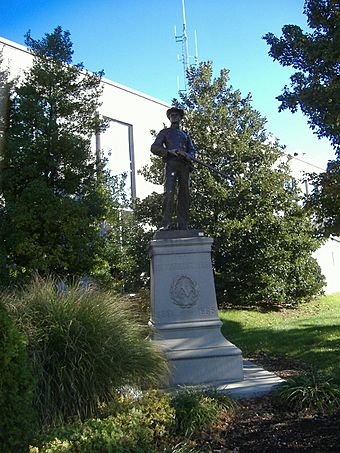Confederate Monument in Owensboro facts for kids
Quick facts for kids |
|
|
Confederate Monument in Owensboro
|
|
 |
|
| Lua error in Module:Location_map at line 420: attempt to index field 'wikibase' (a nil value). | |
| Location | 212 St Ann St, Owensboro, Kentucky |
|---|---|
| Built | 1900 |
| Architect | George Julian Zolnay, sculptor; John Williams Foundry, New York, N.Y., bronze casting; Weony & Brown, Richmond, Va., granite pedestal |
| MPS | Civil War Monuments of Kentucky MPS |
| NRHP reference No. | 97000708 |
| Added to NRHP | July 17, 1997 |
The Confederate Monument in Owensboro is a statue that stands on a stone base. It is located on the lawn of the Daviess County Courthouse in Owensboro, Kentucky. This monument was built to honor soldiers who fought for the Confederate States during the American Civil War (1861-1865).
Contents
Owensboro During the Civil War
In the summer of 1861, a group of soldiers who supported the Confederacy was formed in Owensboro. The war made life difficult for the city. It stopped river travel, which was important for Owensboro's trade. Confederate soldiers sometimes attacked the city. They even burned down the courthouse. A historical sign near the monument tells about three local soldiers who received a special award for their bravery in Confederate battles.
What the Monument Looks Like
The monument has two main parts: a tall stone base and a statue on top.
The Stone Base
The base is made of granite and is about nine feet tall. On the front of the base, you can read:
Below these words is a special symbol. It's a wreath around the first national flag of the Confederate States. This flag had 13 stars. It was used by the Confederacy to show they believed Kentucky was part of their group. However, Kentucky's official government stayed loyal to the United States. Under the symbol, the years 1861—1865 are carved, marking the years of the Civil War.
On the back of the base, it says:
The Soldier Statue
On top of the stone base is a seven-foot-tall bronze statue. It shows a Confederate soldier standing ready with a rifle. He is wearing a short jacket and a slouch hat. A famous sculptor named George Julian Zolnay created this statue.
Why and When the Monument Was Built
In 1893, the local government in Daviess County allowed a monument to be placed on the courthouse lawn. This monument was meant to remember the Confederate soldiers who had died.
After several years of raising money, the monument was finally put in place on September 21, 1900. This was done by a group called the John C. Breckinridge Chapter of the United Daughters of the Confederacy (U.D.C.).
Many people came to the dedication ceremony. There were speeches and music. Some reports say that over 4,000 people attended the event.
Part of a National List
On July 17, 1997, the Confederate Monument in Owensboro was added to the National Register of Historic Places. This is a list of important historical sites in the United States. It was one of many Civil War monuments in Kentucky added to this list at that time.
Moving the Monument
Over the years, there have been discussions about moving the monument from the courthouse lawn. In 2012 and 2017, some local groups asked the Daviess County government to remove it.
After more discussions in the summer of 2020, the Daviess County government decided to remove the monument. They voted on August 6, 2020, to move it to a new location. A special committee was formed to find a new place for the monument. The monument will stay where it is until a new location is approved.
Gallery



